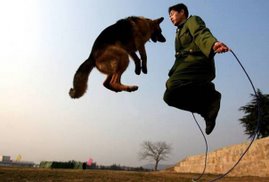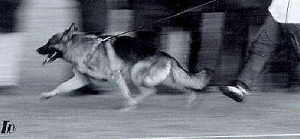AB 1634 - California Healthy Pets Act
The Issue
The California Assembly Bill AB 1634 (“Bill”) is sponsored by Assemblyman Lloyd Levine and is being marketed as a means to reduce the numbers of dogs and cats in California shelters.
In essence the Bill will prohibit any person in California from owning or possessing any unaltered cat or dog over the age of four months, unless that person possesses an intact permit, with unspecified "intact permit fees," and impose severe financial (and possibly criminal) penalties for noncompliance.
Note - Passing of this Bill in any form will entice other States and Jurisdictions to follow suit.
Accordingly to information available, this Bill may go to Committee on April 17 and the USA is taking proactive steps to engage it with a view to either "kill it" or have it suitably modified.
To read the original Bill, please click here.(Please use the back arrow key of your browser to return to the Blog)
Proposed Action
1. Provided it does go to Committee and we are given adequate floor time, a senior Member of the Executive Committee will be making a presentation on the USA’s position on the Bill. It is also likely that the AKC will be taking a very determined stand against the Bill as although AKC (and certain other Breed Registries) registered dogs are "exempt" from the provisions they are not "exempt" from paying the intact permit fees. The USA is also supportive of the actions taken by some of its members in fighting the Bill from other fronts and will encourage you to visit the Save Our Dogs website ( see Useful Links on right).
2. All of this notwithstanding, our collective objections will be heard more clearly if the USA membership rallies and voices their views by writing/faxing/calling their Elected Representative(s).
Letter Format
Such that you may have some guidance on what you can include in your letter, we give below a format of a USA suggested letter as well as the letter contained in Save Our Dogs site.We recommend that you choose paragraphs as appropriate from any of the letters as the intent is to defeat the Bill and choosing a variety of content will preclude your letter being considered a canned presentation. We, however, urge that you use some language in your letter which will identify you as an USA member.
How to find your Elected Representative(s).
Please click here to find out who represents you in the California State Legislature.(Please use the back arrow key of your browser to return to the Blog.)
Suggested USA Letter
Date
# Any Street
Any City, CA Zip Code
The Honorable full name
State Capitol
Room number
Sacramento, CA Zip Code
Dear Assembly Member or Senator (use last name)
AB 1634 - California Healthy Pets Act
(Suggested Opening Paragraph – modify as appropriate)
I am a Constituent and a responsible dog owner (add breeder, trainer etc as appropriate) belonging to The United Schutzhund Clubs of America ("USA") and am writing to express my opposition to California Assembly Bill AB 1634 (“Bill”). Whilst the intent of the Bill “to reduce the number of cats and dogs in shelters” is indeed laudable; it will nonetheless be ineffective. It will only serve to penalize responsible dog owners and breeders. Furthermore, it will encourage puppy buyers to import from out of state or even from overseas from "puppy factories" and other commercial breeders. Also, it will encourage those who are irresponsible to not license their pets and remain "under the radar" so to speak. If enacted this Bill would impose undue financial hardships to “in state” German Shepherd Dog (and other Breed) owners, breeders and trainers.
(Suggested Paragraphs – choose/modify as appropriate)
As you are aware, German Shepherd Dogs have a time-honored tradition of protecting the innocent and vulnerable members of society. They protect and assist police officers and military personnel in fighting crime and terrorism. They serve worldwide as police dogs, military dogs, search-and-rescue dogs, guide dogs for the blind, therapy dogs, and assistance dogs. They also serve as loyal and faithful family pets.
Mandatory spay and neuter provisions, as envisaged by the Bill, would prevent the selection of breeding-quality working German Shepherds, and could effectively wipe out in one generation, what breeders have strived to safeguard and develop for a century. It is simply not practical for any breeder to identify dogs which have the inherent breeding potential at a young age as four months resulting in them being required to pay intact permit fees. The choice of spaying or neutering should be left to the dog owners as it otherwise infringes on their civil liberties as Citizens of a Free Country.
Although the Bill “exempts” certain dogs if they are registered with certain “approved” Registries and/or serve law enforcement or other such agencies; it still does not exempt these dogs from payment of “intact permit fees” on which there is no "cap" or "limit" in the amounts which can be levied by the local jurisdictions at will and without any justification. Dog owners will be required to subsidize any inefficiency in local animal control and management which will be continually passed across to them in the form of such fees.
This Bill also does not recognize that certain “Registries” such as the USA have strict controls and regulations in place to preclude indiscriminate and improper breeding. Dogs registered with the USA are bred under strict guidelines requiring a variety of certifications as to temperament, obedience, and other canine aspects of good behavior. There is also control imposed on line and in breeding. It is also a pre-requisite for all breeding females and stud dogs to have good health certifications in respect of Hip Dysplasia etc. There are also limits placed on the number of litters that can be registered by the Breeder and the litter (puppies) and the Dam are visited by a Regional Breed Warden to ensure that they are sound, in good health and their environment conforms to USA standards. In addition the puppies are all tattooed to provide effective identification.
The Bill if passed in any form will also impact the livelihood of a number of people in the California who manage either full time or part time to make ends meet by operating small and home based businesses dealing with training, breeding and production of canine related items for sale. In addition, the reduction of purebred dogs in the State will reduce the number of dog shows which are held annually. This and the reduction in sales of dog and cat related food and other items will cause an equivalent reduction in the amount of sales tax collected and also result in some level of unemployment or underemployment. As such, the Bill will cause a tremendous negative impact to the economy of the State.
(Suggested ending Paragraph – modify as appropriate)
The provisions of the Bill are clearly impractical, do not achieve the purpose for it was intended and makes the cure worse than the disease. If the Bill is passed all it will do is to encourage the importation of pups and dogs from out of state/overseas. This does not necessarily mean that these “imported” dogs will not end up in shelters. We strongly oppose this transgression of our rights as law abiding citizens of the State of California and urge you to take all steps as necessary to have the Bill withdrawn.
Yours Sincerely
................
Save Your Dogs Letter
As your constituent and a dog owner, I respectfully ask you to oppose Assembly Bill 1634, the California Healthy Pets Act. This bill is intended to reduce the number of cats and dogs in shelters in California. It will not. It will strip law abiding and ethical dog owners of their rights to their property, increase the number of puppy-mill puppies imported from out of state, and destroy the working dogs of California. It is bad law supporting the radical animal rights agenda of eliminating all domestic animals.
AB 1634 tries to reduce shelter populations by reducing the number of unwanted litters. That is not the source of the problem. Most puppies from unwanted litters are adopted in just days. A few shelters get more puppies than they need, but the excess are sent to other shelters that can adopt out more puppies than they receive. The problem is unwanted adult dogs. We live in a throw-away society and AB 1634 will have no impact on the number of adults in shelters. Owner education and voluntary spay/neuter outreach have proven effective in reducing shelter populations while protecting the rights of law abiding and ethical owners.
AB 1634 includes exemptions for certain working dogs, but in fact these exemptions are useless. The bill exempts trained and certified Guide Dogs, police dogs and search dogs employed by law enforcement. Other dogs must be altered by four months of age. No dog is a trained and certified Guide Dog, police dog, or search dog at four months of age. Typically these dogs are not certified until closer to two years of age so the exemption for certified dogs beyond the current generation is meaningless.
The bill includes an exemption for dogs registered with the AKC, UKC, and ADBA. Many or even most working dogs in California are not registered with one of these kennel clubs. Some are registered with other registries, but many are not and many are unregisterable. The AKC has said that AKC registration is not a sign of good breeding. Kennel club registration has no relationship to whether a dog is a good dog or not. Working dog breeders select the dogs they want to breed based on performance, not paperwork. AB 1634 substitutes the decisions of a government bureaucrat for the judgment and experience of an expert breeder, destroying all working dog breeds in the state.
Mandatory spay/neuter is a step toward eliminating pets in California. It is not a reasonable policy to address the shelter population. It hurts all ethical owners to the benefit of unethical and out of state breeders. I hope you will oppose this bad bill. I look forward to your reply.
Thank you for your consideration.











